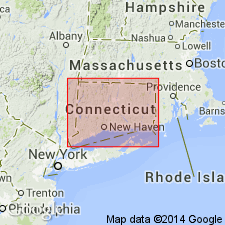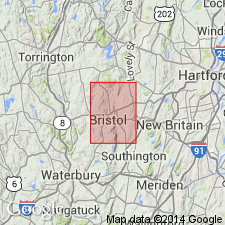
- Usage in publication:
-
- Wildcat Member*
- Modifications:
-
- Age modified
- AAPG geologic province:
-
- New England province
Summary:
Wildcat Member of the Taine Mountain Formation of Early(?) Ordovician age accepted in the Gneiss Dome belt of the Connecticut Valley synclinorium in CT.
Source: GNU records (USGS DDS-6; Reston GNULEX).

- Usage in publication:
-
- Wildcat Member*
- Modifications:
-
- Overview
- Dominant lithology:
-
- Gneiss
- AAPG geologic province:
-
- New England province
Summary:
The Taine Mountain Formation of Stanley (1964) is here adopted in the Collinsville and Bristol quads., CT. Includes three pinstriped units, the Wildcat, Scranton Mountain, and Whigville Members of Stanley (1964), also adopted. Wildcat Member is the basal pinstriped gneiss unit of the Taine Mountain, which correlates with the Savoy Schist of Emerson (1898), Missisquoi Schist or Group of Richardson (1919, 1924) in MA; and the Moretown Formation of Cady (1956) in MA and VT. Inferred age is Middle Ordovician.
Source: GNU records (USGS DDS-6; Reston GNULEX).
For more information, please contact Nancy Stamm, Geologic Names Committee Secretary.
Asterisk (*) indicates published by U.S. Geological Survey authors.
"No current usage" (†) implies that a name has been abandoned or has fallen into disuse. Former usage and, if known, replacement name given in parentheses ( ).
Slash (/) indicates name conflicts with nomenclatural guidelines (CSN, 1933; ACSN, 1961, 1970; NACSN, 1983, 2005, 2021). May be explained within brackets ([ ]).

